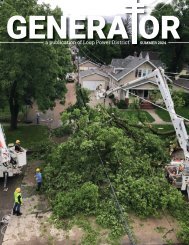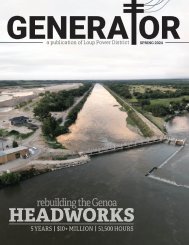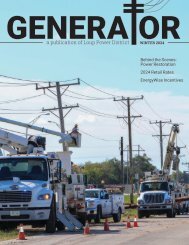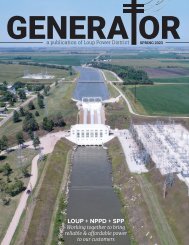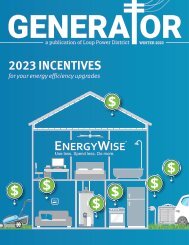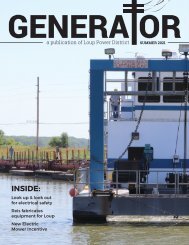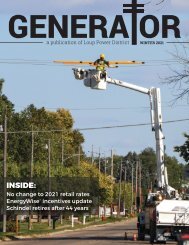Generator — Fall 2022
In this issue: Loup deals with supply chain issues; reptiles and amphibians in Loup territory; Cybersecurity and Public Power Months.
In this issue: Loup deals with supply chain issues; reptiles and amphibians in Loup territory; Cybersecurity and Public Power Months.
Create successful ePaper yourself
Turn your PDF publications into a flip-book with our unique Google optimized e-Paper software.
GENERA OR<br />
a publication of Loup Power District FALL <strong>2022</strong><br />
THIS ISSUE:<br />
Supply Chain Disruptions<br />
Reptiles and Amphibians<br />
in Loup Territory<br />
Public Power and<br />
Cybersecurity Month
BOARD OF DIRECTORS<br />
Alan Drozd<br />
Chairman<br />
Steve Heesacker<br />
First Vice Chairman<br />
Robert Cerv<br />
Second Vice Chairman<br />
Jim Donoghue<br />
Secretary<br />
Dick Tooley<br />
Treasurer<br />
Rich Aerni<br />
Mike Fleming<br />
Ross Knott<br />
Chris Langemeier<br />
Larry Zach<br />
EXECUTIVE STAFF<br />
Neal Suess<br />
President/CEO<br />
Walt Williams<br />
Vice President,<br />
Accounting & Finance/CFO<br />
Todd Duren<br />
Vice President,<br />
Corporate Services<br />
Korey Hobza<br />
Vice President, Engineering<br />
Dan Hellbusch<br />
Vice President, Operations<br />
The Loup <strong>Generator</strong> is<br />
published quarterly<br />
as a service for Loup<br />
employees, families,<br />
friends, and associates.<br />
For feedback, story ideas<br />
and submissions, contact:<br />
Stacy Wemhoff<br />
Communications Coordinator<br />
402-562-5711<br />
swemhoff@loup.com<br />
Protect yourself from cyber<br />
criminals with these tips<br />
In today’s digital world, cyberattacks<br />
are unfortunately nothing new. Cyber<br />
criminals can attack on a multitude of<br />
levels, from large-scale attacks targeting<br />
corporations to smaller phishing attacks<br />
aimed at gaining an individual’s personal<br />
information.<br />
October is Cybersecurity Awareness<br />
Month, but good cyber hygiene should be<br />
practiced year-round. This year’s theme is<br />
“See Yourself in Cyber” – because we all<br />
have a part to play in cybersecurity. When<br />
we hear about massive data breaches, it<br />
can feel overwhelming and lead us to think<br />
we’re powerless as individuals to stop<br />
cyber criminals.<br />
However, there are several practical steps<br />
we can take to safeguard our devices and<br />
data. Here are four easy ways to boost your<br />
cyber hygiene:<br />
1. ENABLE MULTI-FACTOR<br />
AUTHENTICATION.<br />
Also known as two-step verification, multifactor<br />
authentication adds a second step<br />
when logging into an account (to prove<br />
you’re really you), which greatly increases<br />
the security of the account. This second<br />
step could include an extra PIN, answering<br />
See Yourself<br />
in Cyber.<br />
October is Cybersecurity<br />
Awareness Month<br />
Improve your cyber<br />
hygiene by doing<br />
these four things:<br />
1. Enable multi-factor<br />
authentication<br />
2. Use strong<br />
passwords and a<br />
password manager<br />
3. Update software<br />
regularly<br />
4. Recognize and<br />
report phishing<br />
attacks<br />
an extra security question, receiving an email code, or a secure token. Regardless of the type of authentication,<br />
this additional step makes it twice as hard for cyber criminals to access your account. Not every<br />
account offers multi-factor authentication, but it’s becoming increasingly popular and should be utilized<br />
when available.<br />
2. USE STRONG PASSWORDS AND A PASSWORD MANAGER.<br />
Remember, passwords are the “keys” to your personal home online. Your passwords should always be<br />
long, unique and complex. Create passwords using at least 12 characters, never reuse passwords for<br />
multiple accounts, and use a combination of upper- and lower-case letters, numbers and special characters.<br />
If you have a lot of accounts, consider using a password manager app to store them easily and<br />
securely in one place.<br />
3. UPDATE SOFTWARE.<br />
It may seem obvious, but regularly updating software is one of the easiest ways to keep your personal<br />
information secure. Most companies provide automatic updates and will send reminders so you can<br />
easily install the update. If you’re not receiving automatic software updates, set a reminder to do so<br />
quarterly. Be aware that some cyber criminals will send fake updates; these typically appear as a pop-up<br />
window when visiting a website. Use good judgement and always think before you click.<br />
4.RECOGNIZE AND REPORT PHISHING ATTACKS.<br />
Don’t take the bait when cyber criminals go phishing. The signs of a phishing attack can be subtle, so take<br />
the extra time to thoroughly inspect emails. Most phishing emails include offers that are too good to be<br />
true, an urgent or alarming tone, misspellings and poorly-crafted language, ambiguous greetings, strange<br />
requests, or an email address that doesn’t match the company it’s coming from. Most platforms like<br />
Outlook, Gmail, and Mac Mail allow users to report phishing emails. If you suspect a phishing attempt,<br />
take an extra minute to report it.<br />
2 | GENERATOR<br />
Cyber criminals are here to stay, but when we all take a risk-based approach to our cyber behavior, we’re<br />
creating a safer internet for all. Visit www.staysafeonline.org for additional cybersecurity tips.
president’s message<br />
Loup continues to learn about<br />
EVs as they grow in popularity<br />
There has been a lot of discussion over the past<br />
months about electrification in the United States and<br />
the increased use of electric vehicles (EVs) throughout<br />
the country. There have also been several articles and<br />
publications discussing this, with arguments on both<br />
sides regarding the future of electric vehicles.<br />
Electric vehicles are here to stay. The District is seeing<br />
more and more electric vehicles on the road, and<br />
using charging stations throughout Columbus (there<br />
are several) and in other places throughout the State<br />
of Nebraska. Many of these new electric vehicles are<br />
stylish and have a certain flair to them, which makes<br />
them attractive.<br />
One of the big concerns with electric vehicles (especially<br />
those that are all-electric) is the range they can<br />
cover on a single charge. “Range anxiety” is a real<br />
fear for many <strong>—</strong> owners want to make sure there are<br />
charging stations at intervals needed to recharge the<br />
EV. This is one way in which the federal government is<br />
trying to invest money with the states to install a more<br />
robust EV charging system.<br />
Most all-electric vehicles have ranges from 250–300<br />
miles on a full charge. As mentioned previously,<br />
having charging stations at regular intervals will help<br />
promote more widespread use of these EVs in the<br />
future.<br />
In addition, there are fast charging stations and slow<br />
charging stations. Fast charging stations can recharge<br />
a vehicle in approximately 30 minutes, while a slow<br />
charging vehicle may take four hours or more to fully<br />
charge an electric vehicle. This is one reason that most<br />
EV owners/users restrict their use to day trips, or to<br />
work and back.<br />
Hybrid vehicles can run on an electrical charge and<br />
on gasoline. These vehicles relieve the range anxiety<br />
concerns and are popular for long-distance travelling<br />
because a person does not have to worry about<br />
running out of charge while driving and can charge<br />
the vehicle at night.<br />
The federal government, as well as many other local<br />
government officials, believes electric vehicles are the<br />
wave of the future. They may be correct, and we are<br />
just at the beginning of the wave.<br />
The District has both an all-electric vehicle and a<br />
hybrid electric/gasoline vehicle. Both have provided<br />
benefit to the District and we are learning more about<br />
these each day they are in operation.<br />
District management and the Board of Directors<br />
continue to track ongoing trends and updates to the<br />
electric utility industry to provide many opportunities<br />
to our customers.<br />
Electric vehicles and charging stations are just one of<br />
the many trends we are watching. We would also be<br />
happy to discuss these with you, so feel free to contact<br />
us, and we will inform you the best we can.<br />
NEAL SUESS<br />
President/CEO<br />
Loup Power District installed a ChargePoint<br />
charging station at the Columbus General Office<br />
in 2021.The station is networked and can be<br />
accessed through the ChargePoint app which<br />
also helps EV owners locate nearby stations<br />
and sends notifications when the vehicle<br />
is done charging. Owners pay for the<br />
electricity through the app.<br />
FALL <strong>2022</strong> | 3
Amphibians<br />
&Reptiles<br />
in Loup<br />
Territory<br />
The Loup Power District project brought<br />
power and prosperity to our area in the<br />
1930s. Recreation and irrigation opportunities<br />
soon followed.<br />
But there is another benefit that isn’t as<br />
obvious <strong>—</strong> the system has created the<br />
perfect habitat for a wide variety of animals,<br />
especially reptiles and amphibians.<br />
The Genoa Headworks, Lake Babcock, the<br />
canal, and the Tailrace have the diverse<br />
features of wetlands, large sandy areas,<br />
and upland sites that are ideal habitats for<br />
turtles, toads, lizards, and snakes.<br />
The canal banks with overlying vegetation<br />
provide optimal feeding, dwelling,<br />
and escape cover for these species known<br />
as herpetofauna. This becomes especially<br />
important during periods of water scarcity<br />
and drought when many other local waterways<br />
run low or dry up.<br />
Frogs, toads, and snakes love sand <strong>—</strong> and<br />
Loup definitely has plenty of it! They<br />
burrow in the sand to keep cool, hide from<br />
predators, or ambush their prey.<br />
New Century Environmental, a Columbusbased<br />
firm, serves as an environmental<br />
contractor for Loup. Biologists survey plant<br />
and animal species found within the project<br />
area that may be threatened, endangered,<br />
or invasive. They frequently spot a variety of<br />
amphibians and reptiles.<br />
Both are components of aquatic ecosystems.<br />
They serve as both prey and predators,<br />
making them an important part of the<br />
food chain.<br />
The main difference in the two species<br />
is that reptiles are born with lungs<br />
while amphibians are born with gills for<br />
breathing underwater. Reptiles also have<br />
scales, while amphibians have thin, smooth<br />
skin.<br />
Snakes, turtles, and lizards are reptiles.<br />
Frogs, toads, and salamanders are<br />
amphibians.<br />
Within the borders of Nebraska, there are<br />
two species of salamanders, 11 species of<br />
frogs and toads, eight species of turtles,<br />
10 species of lizards, and 29 species of<br />
snakes. Many of these animals are typical<br />
inhabitants of the Great Plains and none are<br />
limited to Nebraska.<br />
There are 13 species of amphibians and 47<br />
species of reptiles in Nebraska, including<br />
one species of lizard recently reported in<br />
Nebraska for the first time.<br />
Although Nebraska has no obvious<br />
geographic barriers within its borders, most<br />
of these species have range limits within<br />
the state.<br />
Fourteen have statewide distributions<br />
and 12 others occur widely over eastern<br />
Nebraska.<br />
So, the next time you’re fishing along the<br />
canal or visiting one of our parks, take a few<br />
minutes to see if you can spot one of these<br />
interesting creatures! u<br />
Associate Biologists Jordan Kort and Seth Gutzmer sample for aquatic<br />
species at the Genoa Headworks. Loup’s hydroelectric license requires that<br />
the District monitor for invasive and endangered species.<br />
Loup has several wetlands within the project boundary that support many<br />
species of amphibians and reptiles. Photos by Michael Gutzmer, New<br />
Century Environmental.<br />
4 | GENERATOR
BULLFROG<br />
• Length: 3.5–6 inches<br />
• Largest true frog in North<br />
America; weighs up to 1.1 lb<br />
• Sex can be determined by size<br />
of tympanum (external ear<br />
located near eye) <strong>—</strong> males<br />
have much larger tympanum;<br />
in females it is the size of eye or<br />
smaller<br />
WOODHOUSE’S TOAD<br />
• Length: 1.75–5 inches<br />
• Dry, watery skin that is a mix<br />
of grays, browns, greens, and<br />
yellows<br />
• The males have a dark throat<br />
while the females have lighter<br />
throats<br />
• Light stripe on the middle<br />
of the back to the snout<br />
COPE’S TREEFROG<br />
• Length: 1–2 inches<br />
• Color depends on<br />
environment, season and<br />
humidity<br />
• Green colors more prominent<br />
during breeding season and in<br />
yearling frogs<br />
• Lightly covered in warts;<br />
smoother than most toads<br />
SNAPPING TURTLE<br />
• Shell length of 8–18 inches;<br />
tail is as long as the shell<br />
• Adults can weigh up to 50 lb<br />
• Prefer water bodies with<br />
muddy bottoms and abundant<br />
vegetation<br />
• Characteristic tubercules<br />
on neck and legs<br />
• Powerful beak-like jaws;<br />
highly mobile head and neck<br />
PAINTED TURTLE<br />
• Length: 5–10 inches<br />
• Live around permanent bodies<br />
of water<br />
• Dark green shell with bright red<br />
and orange markings<br />
• Yellow and red stripes on legs,<br />
neck, face and head<br />
NORTHERN<br />
LEOPARD FROG<br />
• Length: 2–4.3 inches<br />
• Distinct white fold along the<br />
length of the back extending<br />
from each eye<br />
• White, semi-transparent<br />
belly <strong>—</strong> intestinal coils visible<br />
through the skin<br />
SIX-LINED RACERUNNER<br />
• Length: 6–10 inches; tail makes up 70% of length<br />
• Velvety skin with six yellow or green stripes from the<br />
neck to tail<br />
• Pellet-like dorsal scales and rectangular ventral<br />
scales; rough rows of scales on tails<br />
• Adult males express bright blue coloration on their<br />
throats during mating season<br />
Photos by Sam Stukel, United States Fish and Wildlife Service (USFWS): bullfrogs, turtles, leopard frog, Woodhouse's toad.<br />
Photos by Nebraskaland Magazine/Nebraska Game and Parks Commission: Cope’s treefrog, six-lined racerunner.<br />
FALL <strong>2022</strong> | 5
BARRED TIGER SALAMANDER<br />
• Average length: 7.8 inches; can grow to 14 inches<br />
• One of the longest terrestrial salamanders in North America<br />
• Found in a variety of habitats, including forests, meadows, and grasslands<br />
• Use ponds as breeding grounds (sometimes use slow-moving streams)<br />
• Geographic variation in color and pattern; typically a light gray overlain with<br />
scattered black or dirty yellow dots or a network of yellow bars and lines<br />
BULLSNAKE<br />
• Average length: 40–70 inches<br />
• America’s largest snake<br />
• Found in sandy prairies and grasslands;<br />
also inhabit areas with rocky outcrops<br />
• Triangular head with a black band extending from<br />
the corner of the eye to the mouth<br />
PLAINS GARTER SNAKE<br />
• Average length: 15–28 inches<br />
• Mildly venomous, but not to humans<br />
• Found in prairies, open fields, and weedy vacant<br />
lots; prefers low-canopy vegetation<br />
• Feeds mostly on earthworms, minnows,<br />
salamanders, toads, and frogs<br />
Bullsnake and salamander photos by Nebraskaland Magazine/Nebraska Game and Parks Commission. Garter snake by Jessica Bolser, USFWS.<br />
Right: Michael Gutzmer,<br />
Principal with New Century<br />
Environmental, and Associate<br />
Biologist Seth Gutzmer,<br />
complete surveys for invasive<br />
and endangered species<br />
throughout Loup’s territory.<br />
The company’s scientists<br />
and engineers also assess<br />
and manage a variety of<br />
compliance and natural<br />
resources issues throughout<br />
the Great Plains.<br />
Thanks to Michael Gutzmer<br />
and Seth Gutzmer for providing<br />
information about the amphibians<br />
and reptiles that live in our<br />
area.<br />
6 | GENERATOR
AMPHIBIANS<br />
No scales<br />
Smooth, moist, soft skin<br />
Lay eggs in gelatinous masses (no protective shell)<br />
Metamorphosis <strong>—</strong> breathe through gills until lungs develop<br />
Live in and out of water<br />
Whole tongue<br />
REPTILES<br />
Scales<br />
Hard, dry-looking skin<br />
Lay eggs with a shell<br />
No metamorphosis <strong>—</strong> look like adults when born<br />
Tend to live on land, but may spend time in water<br />
Bifurcated tongue<br />
Top Photos by Sam Stukel, USFWS.<br />
There are nine species of turtles in Nebraska, but only the painted turtle and snapping turtle<br />
are found throughout the state.<br />
Top left: A group of painted turtles sun themselves. Photo by Mike Gutzmer.<br />
Top right: Seth Gutzmer, an Associate Biologist with New Century Environmental,<br />
documents a juvenile snapping turtle. Photo by Mike Gutzmer.<br />
Left: A snapping turtle has a strong, bony beak without teeth. They will eat almost anything<br />
they can catch. Photo by Grayson Smith, USFWS.<br />
FALL <strong>2022</strong> | 7
8 | GENERATOR
Loup among utilities dealing<br />
with supply chain disruptions<br />
Dave Rosno never imagined he’d have such<br />
difficulty purchasing 5/8-inch by 14-inch<br />
bolts.<br />
“It’s something that we use everyday,” he<br />
said. “What normally would be in stock at a<br />
warehouse is taking up to 12 weeks to get,”<br />
he said.<br />
Bolts are just the tip of the iceberg, according<br />
to Rosno, who serves as Loup’s Chief Storekeeper.<br />
The biggest problem is not knowing<br />
what the next problem is going to be.<br />
“You don’t know there’s going to be a<br />
problem with the supply until you go to order<br />
and then it’s almost like a panic,” he said.<br />
Across the country, the supply of critical<br />
equipment and materials is decreasing while<br />
demand continues to grow, widening the<br />
gap between what is available and what is<br />
needed.<br />
Electric utilities are experiencing shortages<br />
of distribution transformers, meters,<br />
conductor materials, and bucket trucks due<br />
to the ongoing economic impacts from the<br />
COVID-19 pandemic.<br />
Delayed investments and expanding lead<br />
times for new equipment caused by a lack<br />
of materials and labor will continue to<br />
compound the problem<strong>—</strong>possibly for years<br />
to come.<br />
Korey Hobza, Vice President of Engineering,<br />
said Loup’s transformer suppliers forecast<br />
a shortage and alerted Loup which consequently<br />
ordered extra transformers.<br />
“We’ve been able to get the transformers we<br />
need,” Hobza said. “But the lead times and<br />
prices have increased significantly.”<br />
Loup is planning a new Columbus substation.<br />
The timeline for a distribution transformer<br />
increased from 48 to 110 weeks.<br />
Residential transformers have an average<br />
lead time of about 45 months. He said some<br />
companies are offering bids that are subject<br />
to change based on the delivery date.<br />
In a recent survey of public power utilities,<br />
80 percent reported having either padmounted<br />
or pole-mounted distribution<br />
transformer inventories that are lower today<br />
than they were in 2018.<br />
Loup Power District’s supply of residential pole-mount transformers at the Columbus<br />
Service Center. The District has been able to maintain its supply of transformers despite a<br />
nationwide shortage.<br />
Utilities are discussing the issue with<br />
the federal government, working with<br />
manufacturers, and with the entire sector<br />
to encourage additional production and<br />
sharing of transformers.<br />
Shop and Transportation Superintendent<br />
Mark Hanel is feeling the same pressures as<br />
Hobza and Rosno.<br />
He ordered two dump trucks earlier this year<br />
with an estimated delivery date of the first<br />
quarter of 2023. That date has since been<br />
pushed to the end of next year.<br />
Some vehicle orders were simply cancelled<br />
outright. The cost is “uncertain at best” for a<br />
few trucks still on order. On the bright side,<br />
Hanel said his team has been able to access<br />
the parts needed to maintain the District’s<br />
existing fleet.<br />
Rosno's strategy to deal with ongoing supply<br />
chain issues is to shop around and find new<br />
vendors. He is also asking vendors what<br />
they are carrying for other utilities to see if<br />
Loup can adjust and use slightly different<br />
products <strong>—</strong> maybe a standard pole instead of<br />
a custom-drilled pole.<br />
Hobza said that strategy is working for<br />
engineering as well <strong>—</strong> purchasing an “offthe-shelf”<br />
transformer with specs that<br />
closely match Loup’s means better price and<br />
availability.<br />
On top of simply finding supplies, Rosno has<br />
to weigh product cost against the delivery<br />
lead time.<br />
“It's not always about price at this point,"<br />
Rosno said. “It's if we will get it at all.”<br />
He has been able to maintain inventory by<br />
shopping around <strong>—</strong> often getting lucky and<br />
stumbling upon vendors with enough inventory<br />
at the right time. Sometimes he orders<br />
from one vendor while waiting on another.<br />
But, more inventory is always better than not<br />
enough.<br />
“We want to be prepared,” he said. “We<br />
don’t want to run ourselves short in case of a<br />
storm.”<br />
FALL <strong>2022</strong> | 9
Retiree Profile<br />
STEVE<br />
CZARNIK<br />
Steve Czarnik has been a hard worker<br />
his whole life.<br />
And although he has been retired for<br />
five years, not much has changed.<br />
He still raises cattle, harvests for neighbors,<br />
and tackles projects around his farm.<br />
But he can now do those projects on<br />
his own schedule <strong>—</strong> a schedule that has<br />
more time for his wife, children, and<br />
grandchildren.<br />
“We get to spend more time together,”<br />
he said.<br />
* * *<br />
Back in 1988, Steve heard Loup Power<br />
District had a Maintenance Man opening<br />
at the Genoa Headworks.<br />
He had been working at the same job<br />
for 15 years and was ready for a change.<br />
Plus, he’d heard that Loup was a good<br />
company to work for.<br />
He got the job and immediately enjoyed<br />
the variety of tasks. He worked on the<br />
dredge, steamed ice from the canal intake<br />
gates, cut trees along the canal banks, and<br />
hauled dirt and rock.<br />
Three years later, he was promoted to<br />
Equipment Operator. In 1997, he was named<br />
Dredge Operator and became Heavy Equipment<br />
Operator in 1998, staying in that role<br />
until retirement in 2017.<br />
Throughout his career, Steve continued<br />
to enjoy the variety of working at the<br />
Headworks. Sometimes inside the shop,<br />
others outside. He also liked running large<br />
equipment.<br />
“Loup always had very nice equipment,”<br />
he said. “It was a joy to operate.”<br />
Even so, that part of the job could also be<br />
stressful at times. He had to be vigilant and<br />
careful in his work to be sure his coworkers<br />
remained safe. He had to double check the<br />
rigging, make sure he set equipment in the<br />
right place.<br />
“I was responsible. If something<br />
happens, it’s my fault,” he said. “You had to<br />
pay attention and be very careful.”<br />
But the best part of the job, was definitely<br />
the people he worked with for all his years.<br />
And that’s the part he still misses today.<br />
“It is a family. They’re your brothers,” he<br />
said. “You laugh with them. And sometimes<br />
you even cry with them.”<br />
* * *<br />
During his years at Loup, Steve also<br />
farmed and raised cattle.<br />
There were days when he came home and<br />
wanted to sit and rest, but there was always<br />
10 | GENERATOR<br />
Steve Czarnik retired from Loup Power District in 2017 after<br />
nearly 30 years of service. Today, he can spend more time<br />
with his wife and dogs (above), and taking care of his cattle.<br />
work to do.<br />
Ten years ago, he decided to step away<br />
from farming and rent out his cropland. He<br />
continues to care for 70 head of cattle.<br />
“I gotta have a reason to get up in the<br />
morning and that’s a pretty good reason,”<br />
he said. “They keep me busy from the first of<br />
April to June calving.”<br />
He checks on them 10–15 times a day<br />
during those months. In the winter, he needs<br />
to haul hay to feed them.<br />
In the summer, Steve helps his renter<br />
with irrigation. In the fall, he chops silage<br />
and harvests corn for neighbors.<br />
But that’s not all.<br />
“Then there’s this honey do list,” he said.<br />
“I can’t seem to get it to shrink.”<br />
His wife, Sue, counters that if he wasn’t<br />
getting a little older and slower maybe he’d<br />
have an easier time keeping up.<br />
Their banter continues as Steve talks<br />
about how nice it is to make his own<br />
schedule most days. And take a break on<br />
those really hot or cold days.<br />
“I can take a break at 2 p.m. and go in the<br />
house to get on my wife’s nerves,” he jokes.<br />
Sue just retired in December 2021 and<br />
the couple has really enjoyed having a little<br />
more freedom to go places and spend time<br />
together.<br />
She also really enjoys evening rides<br />
to check cattle with Steve or just relaxing<br />
outside. “One thing we both enjoy doing is<br />
sitting on our deck with the dogs,” she said.<br />
They have a great view to watch the<br />
neighbors farming or catch a glimpse of<br />
wildlife. They also inherited a pair of tame<br />
turkeys who need regular attention.<br />
Overall, it is a great new chapter of life,<br />
Sue said. “We feel more free now.”<br />
Sue and Steve Czarnik have three children:<br />
Heather, Ryan, and Eric. They also have four<br />
granddaughters and one grandson.
Is it safe to eat your food after an outage?<br />
Severe winds, lightning and even squirrels can temporarily cause<br />
the power to go out. We understand power outages of any length can<br />
be frustrating, especially when your fridge is stocked with perishable<br />
foods.<br />
Extended power outages are rare, but when they occur, it’s important<br />
to understand food safety measures to take to avoid illness.<br />
Here are a few food safety tips to keep in mind before, during and<br />
after a power outage.<br />
BEFORE AN OUTAGE<br />
A good rule of thumb is to keep an emergency supply kit on hand.<br />
Be sure to include nonperishable food items like bottled water,<br />
powdered milk, canned goods, cereal and protein bars in your emergency<br />
kit.<br />
If you have advance warning that an outage is possible, fill a<br />
cooler with ice <strong>—</strong> just in case the outage spans several hours. Having<br />
a cooler ready to go can buy extra time for your refrigerated, perishable<br />
items.<br />
DURING AN OUTAGE<br />
Do not open the refrigerator or freezer unless absolutely necessary.<br />
An unopened refrigerator will keep food cold for about four<br />
hours. A half-full freezer will keep food frozen for about 24 hours and<br />
a full freezer for about 48 hours.<br />
If it looks like the power outage will last longer than four hours,<br />
move your important perishable items to an ice-filled cooler.<br />
AFTER AN OUTAGE<br />
If refrigerated foods have been exposed to temperatures higher<br />
than 40 degrees for more than two hours, the American Red Cross<br />
recommends discarding the items. If any foods have an unusual<br />
color, odor or texture, they should be thrown away.<br />
While most perishable foods should be thrown out after an<br />
extended outage, there are a few items that are safe to consume after<br />
a two-hour exposure to 40+ degrees:<br />
• hard cheeses that are properly wrapped<br />
• butter or margarine that is properly wrapped<br />
• taco, barbecue and soy sauces<br />
• peanut butter, jelly, mustard, ketchup and relish<br />
The best way to avoid illness from spoiled food during or after<br />
an outage is to follow the four-hour rule of thumb. After an outage,<br />
always smell and inspect foods before consuming and remember:<br />
when in doubt, throw it out.<br />
To learn more about food safety after an emergency,<br />
visit ready.gov/food.<br />
FALL <strong>2022</strong> | 11
employee notes<br />
BOB ANDERSON<br />
Dredge Operator<br />
Bob Anderson of<br />
Genoa retired from<br />
Loup Power District<br />
after 25 years of<br />
service.<br />
Anderson joined<br />
Loup in 1997 as<br />
a Maintenance<br />
Man at the Genoa<br />
Headworks. He<br />
was promoted to<br />
RETIRED<br />
Equipment Operator<br />
at the Headworks in 2002. In 2016,<br />
Anderson was promoted to Dredge<br />
Operator and he stayed in that position<br />
until his retirement.<br />
As a Dredge Operator, Anderson was a<br />
member of the team that operates and<br />
maintains the District’s dredge at the<br />
Genoa Headworks located six miles<br />
southwest of Genoa.<br />
Anderson is a graduate of Genoa High<br />
School and attended Wayne State<br />
College. He and his wife, Michelle, are<br />
the parents of two children: Tanner and<br />
Halie.<br />
ANDY WALLIN<br />
Albion Division Crew Leader<br />
Andy Wallin was<br />
promoted to Crew<br />
Leader for the Albion<br />
Division. In his new<br />
role, Wallin will lead<br />
the crew in charge<br />
of construction<br />
and maintenance<br />
of Loup’s electrical<br />
transmission and distribution<br />
system in<br />
the Albion Division.<br />
PROMOTION<br />
Wallin joined Loup<br />
Power District as a Line Technician at<br />
the Columbus Service Center in 2011.<br />
He was promoted to Journey Line<br />
Technician in 2014 and remained in that<br />
position until this promotion.<br />
Wallin graduated from Newman Grove<br />
High School and earned an Associate<br />
of Applied Science Degree in Utility<br />
Line from Northeast Community College<br />
in Norfolk.<br />
ERIC OLSUFKA<br />
Maintenance Technician<br />
Eric Olsufka joined Loup Power District<br />
as a Maintenance Technician at the<br />
Genoa Headworks.<br />
In his new role,<br />
Olsufka is responsible<br />
for maintaining<br />
District parks, facilities,<br />
and equipment.<br />
He will also assist<br />
the Dredge/<br />
Maintenance Canal<br />
Technicians and<br />
serve on the dredge<br />
during the dredging<br />
season.<br />
Olsufka is a graduate of Columbus<br />
High School. He and his wife, Kim, live<br />
in Genoa with their three children <strong>—</strong><br />
Mila, Tate, and Jake.<br />
GREG BADSTIEBER<br />
Customer & Energy Services Coordinator<br />
Greg Badstieber<br />
joined Loup Power<br />
District in 2012 as an<br />
Engineering Technician<br />
II in the Engineering<br />
Department.<br />
He was promoted to<br />
Engineering Technician<br />
I in 2015 and<br />
was named Customer<br />
and Energy<br />
Services Coordinator<br />
in 2019.<br />
WELCOME<br />
10 YEARS<br />
Badstieber promotes heat pumps<br />
and energy efficiency to customers,<br />
contractors, engineers, architects, and<br />
distributors. He oversees the EnergyWise<br />
program that Loup offers in<br />
partnership with NPPD. He also works<br />
with key accounts and assists customers<br />
with billing concerns.<br />
Badstieber is a graduate of Columbus<br />
High School. He earned an Associate<br />
of Applied Science degree from<br />
Southeast Community College. He also<br />
has a Bachelor of Science degree in<br />
Business Management from Peru State<br />
College.<br />
He and his wife, Sandi, are the parents<br />
of two daughters, Elle and Ayla.<br />
TIM NOVICKI<br />
Journey Line Technician<br />
Tim Novicki of<br />
Columbus has<br />
retired from Loup<br />
Power District after<br />
33 years of service.<br />
Novicki joined<br />
Loup in 1989 as<br />
an Apprentice<br />
Line Technician<br />
in Columbus and<br />
was promoted to<br />
Line Technician<br />
RETIRED<br />
in 1990. He was<br />
promoted to Journey Line Technician<br />
at the Columbus Service Center in 1994<br />
and remained in that position until his<br />
retirement.<br />
Novicki was a member of the crew<br />
responsible for the construction,<br />
operation, and maintenance of electric<br />
transmission and distribution systems<br />
and substations in the Columbus<br />
Division.<br />
He is a graduate of Columbus Scotus<br />
High School and earned an Associate<br />
of Applied Science Degree in Utility<br />
Line from Northeast Community College<br />
in Norfolk. Novicki and his wife,<br />
Connie, reside in Columbus.<br />
SCOTT SNYDER<br />
Headworks Operator<br />
Snyder joined Loup<br />
in 1992 as a Maintenance<br />
Man at the<br />
Genoa Headworks.<br />
He was promoted to<br />
Dredge Operator in<br />
1998 and was named<br />
Headworks Operator<br />
in 2018.<br />
Snyder is a member<br />
of the team that<br />
operates and maintains<br />
the District’s<br />
dredge at the Genoa Headworks.<br />
30 YEARS<br />
Snyder is a native of Genoa and a<br />
graduate of Genoa High School.<br />
He and his late wife, Rose, are the<br />
parents of a daughter, Tanya, and a<br />
grandson, Easton.<br />
12 | GENERATOR
ALVIN MEYER<br />
Newman Grove Local Superintendent<br />
Alvin Meyer<br />
joined Loup<br />
in 1997 as a<br />
Lineman at<br />
Albion. He was<br />
promoted to<br />
Journeyman<br />
Lineman in<br />
2003 and was<br />
named Newman<br />
Grove Local<br />
Superintendent<br />
in 2020.<br />
25 YEARS<br />
Meyer is responsible for overseeing<br />
the maintenance and construction of<br />
Loup’s electric power transmission<br />
and distribution system in the Newman<br />
Grove and Lindsay areas. He also<br />
directs customer service in the area.<br />
Meyer is a native of Winnetoon, Neb.,<br />
and a graduate of Creighton High<br />
School. He earned an Associate of<br />
Applied Science Degree in Utility Line<br />
from Northeast Community College in<br />
Norfolk.<br />
WHEELCHAIR-ACCESSIBLE PIER AT LAKE<br />
Loup partnered with the Lower Loup Natural Resources District to construct an<br />
ADA-compliant fishing pier along the north shore of Lake North. It extends 30<br />
feet into the lake with a 12'×24' platform and railing. The pier was constructed by<br />
Groundscapes Inc. It is open to the public year-round.<br />
He and his wife, Jenny, have four<br />
children and nine grandchildren.<br />
CONNER LUSCHE<br />
Journey Line Technician<br />
Conner Lusche<br />
joined Loup<br />
Power District<br />
as a Journey<br />
Line Technician<br />
in Columbus.<br />
In his new<br />
role, Lusche is<br />
member of the<br />
crew that is<br />
responsible for WELCOME<br />
the construction,<br />
operation,<br />
and maintenance of Loup’s electrical<br />
transmission and distribution systems<br />
and substations in the Columbus<br />
Division.<br />
Lusche is a graduate of Scotus Central<br />
Catholic High School and earned an<br />
associate’s degree from Northeast<br />
Community College.<br />
He and his wife, Demi, live in<br />
Columbus.<br />
NEW VOLLEYBALL COURT AT HEADWORKS PARK<br />
The March 2019 storm and flooding caused significant damage to the Genoa<br />
Headworks. The park reopened to camping in April 2021 following repairs. A new<br />
60'×30' volleyball court was completed this summer and is open for public use at no<br />
charge.<br />
FALL <strong>2022</strong> | 13
Communities<br />
receive nearly<br />
$1.3 million<br />
Loup Power District officials<br />
recently delivered lease payments<br />
totaling nearly $1.3 million to area<br />
communities. Each of these communities<br />
owns their electric distribution<br />
systems. These payments<br />
compensate them for the use of<br />
those systems for the second quarter<br />
of <strong>2022</strong>. Communities use the funds<br />
for a variety of public projects.<br />
The payments were:<br />
Columbus <strong>—</strong> $996,594.85<br />
Platte Center <strong>—</strong> $9,830.01<br />
Monroe <strong>—</strong> $8,684.75<br />
Tarnov <strong>—</strong> $1,336.92<br />
Creston <strong>—</strong> $5,544.10<br />
Humphrey <strong>—</strong> $21,945.08<br />
Lindsay <strong>—</strong> $45,549.05<br />
Cornlea <strong>—</strong> $1,631.93<br />
Newman Grove <strong>—</strong> $15,462.72<br />
Duncan <strong>—</strong> $14,754.02<br />
Fullerton <strong>—</strong> $27,420.43<br />
Genoa <strong>—</strong> $20,498.23<br />
Belgrade <strong>—</strong> $2,971.07<br />
Richland <strong>—</strong> $2,265.46<br />
Howells <strong>—</strong> $17,477.17<br />
Leigh <strong>—</strong> $13,554.86<br />
Clarkson <strong>—</strong> $16,463.95<br />
Albion <strong>—</strong> $39,350.90<br />
Cedar Rapids <strong>—</strong> $12,756.62<br />
Primrose <strong>—</strong> $1,297.18<br />
Petersburg <strong>—</strong> $8,401.92<br />
St. Edward <strong>—</strong> $15,502.97<br />
Total <strong>—</strong> $1,299,294.19<br />
Q: What is an<br />
energy vampire?<br />
GHW SETTLING BASIN BANK WORK<br />
Repair work from a 2019 storm that caused flooding and canal breaches is finally<br />
nearing completion.<br />
As flood water spilled over the intake gates, it eroded the north bank of the settling<br />
basin and destroyed the Headgates Operator’s home (bottom photo). Water has<br />
continued to erode fill along the bank, dumping it into the canal’s settling basin.<br />
To fix the problem, a sheet pile wall is being installed. The 30' pilings are driven 20' in<br />
the ground with tiebacks to secure the wall.<br />
A wingwall was built in a similar manner to fix the one that was also destroyed in 2019.<br />
An energy vampire is a device that<br />
continues to use energy and drain<br />
power, even when it is turned off.<br />
They lurk in your home, taking the<br />
form of phone chargers and cable<br />
boxes, computer cords and coffee<br />
pots. These phantom energy suckers<br />
can account for as much as 20% of<br />
your monthly electricity bill.<br />
Q: What is the quickest way<br />
to slay an energy vampire?<br />
As simple as it sounds, all<br />
you need to do is identify the<br />
culprits and unplug them.<br />
14 | GENERATOR
LINE RETIREMENT<br />
Loup retired a 34.5kV line north of Country Club Shores in Columbus at<br />
the end of August. There were two transmission lines on the poles,<br />
but one had not been used for a number of years.<br />
Taking down the extra line reduced load on the poles<br />
and therefore reduces the chance of them going<br />
down in a storm. The crossarms and<br />
distribution lines were raised during<br />
the process to add extra clearance.<br />
The area is typically quite wet. However, the lack of rain dried up<br />
the ground enough that employees could drive trucks to the site.<br />
The entire Columbus team and three local superintendents worked<br />
on the project. The large crew was able to finish the project more<br />
quickly to reduce the outage time for customers in the area.<br />
Above: Line Technician Michael Lange (left) and Arborist Crew<br />
Leader Trent Konwinski.<br />
FALL <strong>2022</strong> | 15
2404 15th Street | PO Box 988<br />
Columbus, NE 68602-0988<br />
PUBLIC POWER MONTH<br />
DID YOU<br />
KNOW?<br />
Nebraska is the only state in the nation served entirely<br />
by public power electric utilities.<br />
Community-owned utilities mean that<br />
NEBRASKANS ARE WORKING FOR NEBRASKANS.<br />
Nebraska’s electric utilities use a diverse mix of fuel<br />
resources to generate electricity, such as wind, water, coal,<br />
nuclear, natural gas, solar and methane.<br />
Nebraska’s electric utilities<br />
are governed by locally elected<br />
or appointed boards and councils.<br />
This means<br />
YOU HAVE A VOICE IN THE<br />
DECISIONS MADE BY YOUR<br />
LOCAL UTILITY.<br />
Public power<br />
electric utilities<br />
are not-forprofit,<br />
meaning<br />
there’s no profit<br />
motive and no<br />
shareholder<br />
pockets to pad <strong>—</strong><br />
simply affordable,<br />
cost-of-service<br />
electric rates for<br />
consumers.<br />
Each dollar of a public power employee’s<br />
paycheck circulates through the local<br />
economy an estimated four to five times.<br />
KEEPING LOCAL DOLLARS LOCAL.<br />
Nebraska’s electric utilities pay more than<br />
$100 million<br />
to communities they serve each year in lieu of taxes.<br />
Those dollars stay local, helping<br />
EMPOWER OUR HOMETOWNS.



